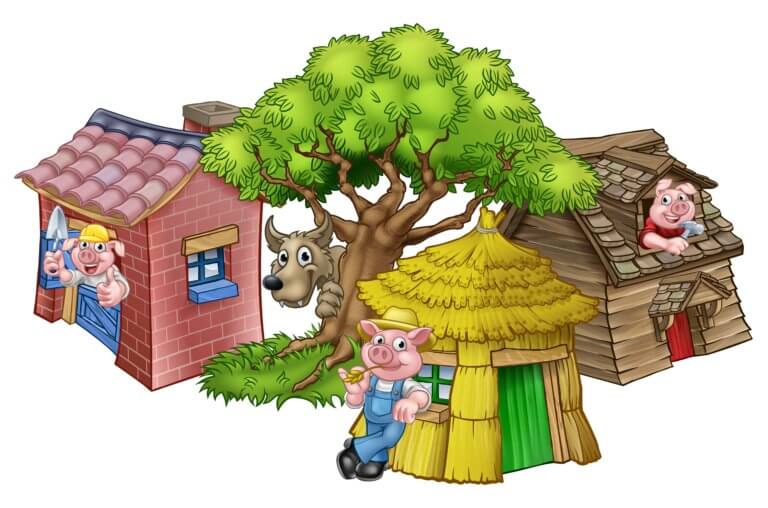The Three Little Pigs
Lets explore the lessons to be learned from the story of The Three Little Pigs and how it pertains to your dental health and future
When I asked a patient if he had heard the story of the three little pigs, he answered in the affirmative. In fact, who does not know that famous children’s story?
Before I get started today, I’m sure that most of you think we will spend some time discussing eating habits and cleaning our mouths after we eat. We could discuss techniques, timing, etc. After all, we are talking about pigs. That will have to wait for another time because I want to focus on understanding the story and where two of our three little piggies went wrong.
Let us take a moment to analyze their thought pattern. We have to remember what we are discussing. Pigs may be sloppy and dirty, but do they have to be unintelligent? Not necessarily. What were they thinking when the first two pigs built their respective houses out of straw and sticks? After all, they were out in the world with all types of weather and evils, as we see when our villain, the wolf, enters. Why did they build such flimsy homes?
So what failed in their thought process? It would appear that they failed to anticipate what would happen as time passed. They did not plan properly for future events. They built structures that were not capable of withstanding too much abuse. This lack of preparedness led to their downfall. Not anticipating future forces or insult to their dwellings.
Planning for Your Dental Future
All of you should be asking, So what does all this have to do with teeth?
Whenever I look at a tooth that needs repair, I have to consider what will happen to this tooth vis-à-vis the rest of the teeth. A tooth does not exist in a vacuum. It may be considered analogous to a gear on a wheel. It functions independently but also is part of a greater team. As such, it has to pull its own weight.
One such factor is, of course, the broken or diseased tooth. I look at how much is left and its inherent strengths or weaknesses. However, I also have to consider what will meet this tooth. In other words, the tooth that opposes this broken tooth creates the grinding and pulverizing forces that result in chewing. Our tooth, needing fixing, must withstand tremendous forces created by the chewing muscles of the face.
But what happens if the opposing structure is not a tooth? Suppose it is a partial or full denture. The force now generated against our tooth is much less. Maybe we don’t need a very extensive fix. Anything that removes decay and restores the tooth to a normal shape may work.
What about adding an extra tooth to fill a gap?
If we can’t place an implant, we can hang a tooth off of another single tooth called a cantilever bridge. Ideally, we like to attach to two teeth, but that is not always possible. Using this type of solution to fill gaps typically puts a lot of stress on the tooth it joins. However, when the opposing tooth that meets the extra tooth is not a tooth but a denture, the forces will be much less.
Why is this so important? A cantilever bridge is a great alternative when we can not place an implant for one reason or another. It even could be a money and time saver for the situation.
Applying the Lesson of The Three Little Pigs
So let’s keep the story of The Three Little Pigs in the back of our minds and try not to mimic their mistakes when putting a mouth back into proper function. These decisions will distinguish between a successful case and one that may fall short of our expectations.
If you have some area in your mouth that is unsightly or troublesome, please feel free to call me and let me try to help you. You and I can properly plan for the future and fix the immediate problem at the same time. I can be reached at 440.951.7856, and I am always happy to talk to you.
Jeffrey Gross, DDS, FAGD is an Ohio licensed general dentist and is on the staff of Case Western Reserve School of Dental Medicine.

